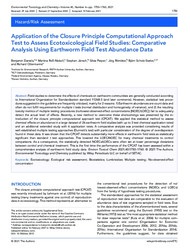Application of the Closure Principle Computational Approach Test to Assess Ecotoxicological Field Studies: Comparative Analysis Using Earthworm Field Test Abundance Data
Daniels, Benjamin
Roß‐Nickoll, Martina
Jänsch, Stephan
Pieper, Silvia
Römbke, Jörg
Scholz‐Starke, Björn
Ottermanns, Richard
Daniels, Benjamin; Roß‐Nickoll, Martina; Jänsch, Stephan; Pieper, Silvia; Römbke, Jörg; Scholz‐Starke, Björn; Ottermanns, Richard, 2021: Application of the Closure Principle Computational Approach Test to Assess Ecotoxicological Field Studies: Comparative Analysis Using Earthworm Field Test Abundance Data. In: Environmental Toxicology and Chemistry, Band 40, 6: 1750 - 1760, DOI: 10.23689/fidgeo-4435.
 |
Dokument öffnen: |
Field studies to determine the effects of chemicals on earthworm communities are generally conducted according to International Organization for Standardization standard 11268‐3 (and later comments). However, statistical test procedures suggested in the guideline are frequently criticized, mainly for 2 reasons: 1) Earthworm abundances are count data and often do not fulfill requirements for multiple t tests (normal distribution and homogeneity of variance), and 2) the resulting toxicity metrics of multiple testing procedures (no/lowest‐observed‐effect concentrations [NOEC/LOEC]) fail to adequately detect the actual level of effects. Recently, a new method to overcome these shortcomings was presented by the introduction of the closure principle computational approach test (CPCAT). We applied this statistical method to assess chemical effects on abundance in a large dataset of 26 earthworm field studies (with up to 3 test chemical application rates) and an additional extended study with 6 application rates. A comparative analysis was provided considering results of well‐established multiple testing approaches (Dunnett's test) with particular consideration of the degree of overdispersion found in these data. It was shown that the CPCAT detects substantially more effects in earthworm field tests as statistically significant than standard t test approaches. This lowered the LOEC/NOEC for many chemical treatments to control comparisons. As a consequence, the statistically detected NOECs/LOECs were often set at lower percentage deviations between control and chemical treatment. This is the first time the performance of the CPCAT has been assessed within a comprehensive analysis of earthworm field study data. Environ Toxicol Chem 2021;40:1750–1760. © 2021 The Authors. Environmental Toxicology and Chemistry published by Wiley Periodicals LLC on behalf of SETAC.
Statistik:
ZugriffsstatistikSammlung:
Schlagworte:
EcotoxicologyEcological risk assessment
Biostatistics
Lumbricidae
Multiple testing
No‐observed‐effect concentration
This is an open access article under the terms of the Creative Commons Attribution‐NonCommercial‐NoDerivs License, which permits use and distribution in any medium, provided the original work is properly cited, the use is non‐commercial and no modifications or adaptations are made.

